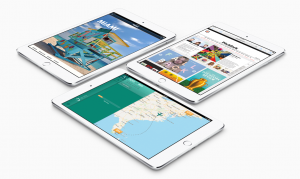Share This
Related Posts
Tags
New Apple Offerings
By Anca Gagiuc on Nov 4, 2014 in Technology
The new holiday lineup from Apple has launched, and Tim Cook calls it “the strongest lineup of products that Apple has ever had.” Joining the iPhone line and the updated iOS are the new iPads, iMac, and OS X Yosemite.
The iPad Air 2 is a 6.1mm thick tablet, down from the previous 7.5mm; this makes it noticeably thinner than the iPhone 6 which is 6.9mm thick. Design-wise, the tablet shares many of the iPhone 6’s features, with a few notable distinctions from the smartphone like the sharply angled chamfer where the screen meets the aluminum body outside the edge of the screen. Despite the ultra-thin profile, the iPad Air 2’s iSight camera sits flush against the body.
The thinness of the device is achieved by laminating the different screen layers into one seamless panel. This process reduces glare and improves clarity. The resolution has not been increased, but the Retina display has been improved. An anti-reflective coating has been applied to the screen, reducing reflections by 56  percent.
percent.
The device runs on an A8X chip and a GPU that Apple says is 180 times faster than the original iPad. It includes a new M8 motion co-processor that “tracks motion, calibrates sensors, and has a barometer,” said Apple. This is the first iPad with 2GB of RAM which not only will speed up overall performance, but will help with multitasking as well. The iPad Air 2 has a 10-hour battery life. New Wi-Fi 802.11ac MIMO and cell radios are in the iPad Air 2, increasing the speed performance.
The home button now includes a Touch ID fingerprint scanner, which works just like those on the iPhones: unlock, complete app and in-app purchases, and works with Apple’s new Apple Pay to buy products in retailer apps that support the system. The 8MP iSight camera features include 43MP panoramas, stop motion, and slo-mo (at 120 frames per second), and the FaceTime camera offers HD video and burst-mode selfies.
Price-wise the new iPad Air 2 is a premium device ranges between $499 and $829. It comes in the colors of the iPhone (gold, space gray, and silver).
The new iPad 3 mini is also among the holiday offerings, it is improved only with the Touch ID as new hardware feature. Compared to the iPad Air 2, the iPad 3 mini lacks in screen quality. Even though the Retina is great, it doesn’t have the fully laminated and anti-glare coats like it does on the Air 2.
Both iPads have Apple-made SIM cards; the Apple SIM was designed to offer more flexibility with carriers and to make it easier for users to stay connected while on the road. The new SIM allows users to choose from any of the available short-term carrier options, supposedly allowing them to jump from carrier to carrier as they wish. When tapping “Set Up Cellular Data” in the settings, a list of available carriers will appear. “So whenever you need it, you can choose the plan that works best for you — with no long-term commitments,” Apple’s iPad product page reads. Initially, the Apple SIM will only be available on 4G LTE and the carriers supported at AT&T, Sprint, and T-Mobile. The starting price for the iPad mini 3 is $399.
The iMac – the best display ever on a computing device and the product that stole the spotlight at the latest Apple keynote. The 27-inch iMac with Retina display has kept the overall design of Apple’s previous all-in-one, but it exploded in pixels, ushering 14.7 million-pixel 5K display with a screen resolution of 5,120 x 2,880. By comparison, it’s seven times as many pixels as 1080p, and 67 percent more than on a 4K panel. It is basically in a league of its own, with an accompanying price tag. Starting at $2,499, the iMac is more expensive than almost any other all-in-one on the market, and yet if you’re a photo and video enthusiast, or simply after superior screen quality, this might be the best option for you.
The Retina display iMac ships with the latest software release, OS X Yosemite. The basic iMac runs on a 3.5GHz quad-core Core i5 processor, 8GB of RAM, 1TB Fusion Drive and AMD Radeon R9 M290X graphics with 2GB of GDDR5 video memory. From here it can be upgraded to a 4GHz quad-core Core i7 (+$250). 16GB of RAM means an extra $200, while 32GB of RAM means another $600. An extra $250 brings a beefier GPU (the AMD R9 M295X) which comes with 4GB or VRAM, not 2. Storage-related, the basic comes at 256GB SSD or 1TB Fusion Drive; you can choose a 3TB disk ($150), a 512GB SSD ($300), or a 1TB SSD ($800).
The iMac has the ports and openings located on the backside towards the bottom, neatly arranged in a row. Here are a headphone jack, SDXC slot, four USB 3.0 ports, two Thunderbolt 2 sockets, and a Gigabit Ethernet jack. Additionally, there is a Kensington lock slot and the power port located behind the stand. The two speakers, although unnoticeable, are squeezed into the chambers on either side of the screen. The old wireless keyboard is part of the package along with either the Apple Magic Mouse (gesture-enabled) or the Magic Trackpad.
The only downside, besides the price, is the fact that you can’t use the display as a second screen; this means that if you already own a new Mac Pro and want the super-sharp display, you’ll have to look to other brands.
Whether you wish to play Santa for your familiy or for yourself, Apple’s new product lineup offers a few strong options for tech lovers. You decide how giving Santa will be this year.
